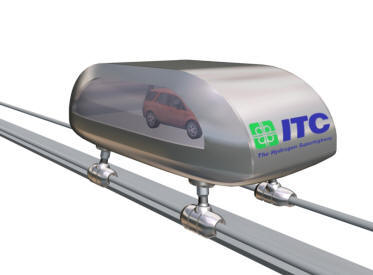Definition
Interstate Hydrogen Highway was brought up by Justin Eric Sutton. This highway mainly depends on hydrogen and water. Hydrogen is obtained in the basic process that produces electricity when sunlight striking EPV(electro photo voltaic panels).panels is then used to convert distilled water into hydrogen and oxygen .while the oxygen could be bottled and sold cheaply the hydrogen would serve as a "battery" store in compressed form in cooling tanks adjacent to the traveler system in utility centers. Electricity is produced by hydrogen using hydrogen fuel cell technology. Electricity generated in hydrogen highway by Magnetic Levitation (MAGLEV) technology may be used to provide for other power needs such as utility stations, access stations lightning and maintenance and rest can be used for domestic usage.
A certain amount of hydrogen would be stored each day to encompass night time travel and weather related burdens. Speed of trailblazer in hydrogen highway is 250-300 MPH. all it takes is "$1,50,00,000 per mile , and $2,50,000 per Rail Car. With an eventual system size of nearly 54,000 miles would yield as much as 45 billion watts of continuous electrical power.
Magnetic Levitation Travel
MAGLEV vehicles of the kind proposed by Mr. Sutton, would travel at nearly 250 miles per hour on cushions of vibration free, magnetically induced air, for a flight a few centimeters off the MAGLEV track. Normally a trip of between 2 and 3 hours by car (plus the commensurate tolls, fuel stops and bathroom/food breaks): travel between Penn Station and the famed Atlantic City Island 116 miles away, at 250 miles per hour, would take considerably less... in fact about 1/5th the time. Travel to and from the resort would have none of the hassles normally associated with a short hop jet flight. It would be accomplished without wasting all that petroleum, fuel that could be better used to explore the Atlantic City seashore community, visit Casinos and take in the night sites. And, another 15-20 minute hop on the Interstate Traveler a day or two later, and one could travel from AC to Philadelphia to see the birthplace of our Country, Independence Hall!

Why even leave your car behind? The design parameters of the Interstate Traveler System not only call for passenger ready MAGLEV vehicles, they also call for "auto carriers".
Such carriers could take the family's Ford 500 for an ultra-fast trip at 250 mph to any location on the system, offloading them to allow the family to motor around the area. A short two week vacation could visit a wide variety of areas covering nearly 2/3 of the Nation, stopping for a day or two to explore each area, then hopping on the Interstate Traveler System and moving on to the next.
No comments:
Post a Comment